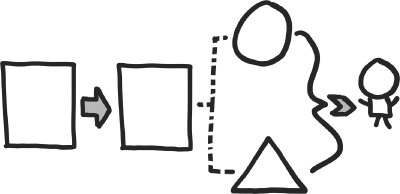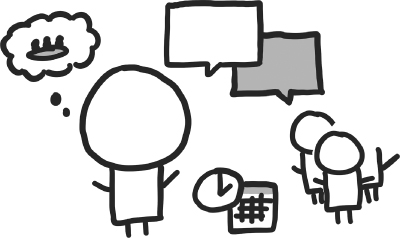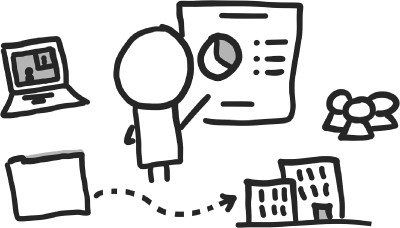

“This is a book of practical magic. Reshan and Steve know that education is a transformative force. In Make Yourself Clear, they give us a case study in the power of great teaching, applied to an unexpected field: business. The result is revelatory. This is alchemy we can use.”
—Jim Best, head of school, The Dalton School
“With their clear and concise style, Richards and Valentine relate successful teaching and learning practices from the classroom to their less obvious counterparts in business, especially sales. Everyone sells something, so anyone can apply their mantra of ‘authenticity, immediacy, and delight’ to their everyday life.”
—Merrick Andlinger, private equity investor, president, Andlinger & Company
“Be a clarifier – not a confuser. This book helps sales and service leaders cultivate teams of ‘teachers’ who can help prospects and customers make meaning out of all the information and choices they face. The sales and service humans who don't get replaced by AI functionality will be those who can give people a way of processing their experiences into strategies and decisions.”
—Tim Reisterer, coauthor of The Three Value Conversations and chief strategy officer, Corporate Visions
“My audience (startup founders, technical decision makers, and software engineers) by definition have chosen careers where continually learning is their biggest competitive advantage. In addition, as they move from startups to big companies and back, they work in roles that didn't exist 10 years ago (for example, data scientist and ecosystems developer). Selling in the traditional sense is an immediate fail to these professionals. Reshan and Steve have accurately described a business methodology of teaching and learning that adds value to this audience and operates in their modern currency: knowledge.”
—Tejpaul Bhatia, startup lead, Google Cloud, New York
“Richards and Valentine's Make Yourself Clear is the first book that I know that capitalizes on what we've gleaned about teaching and learning as applied to business in an age of technology. Whether leading in a school or corporation, or navigating the challenging leadership role of a parent, the wisdom in this book promises to inform your actions. Buy it, but most importantly – read it.”
—Pearl Rock Kane, professor of education, Teachers College Columbia University

Copyright © 2019 by John Wiley & Sons, Inc. All rights reserved.
Published by John Wiley & Sons, Inc., Hoboken, New Jersey.
Published simultaneously in Canada.
No part of this publication may be reproduced, stored in a retrieval system, or transmitted in any form or by any means, electronic, mechanical, photocopying, recording, scanning, or otherwise, except as permitted under Section 107 or 108 of the 1976 United States Copyright Act, without either the prior written permission of the Publisher, or authorization through payment of the appropriate per‐copy fee to the Copyright Clearance Center, Inc., 222 Rosewood Drive, Danvers, MA 01923, (978) 750‐8400, fax (978) 646‐8600, or on the Web at www.copyright.com. Requests to the Publisher for permission should be addressed to the Permissions Department, John Wiley & Sons, Inc., 111 River Street, Hoboken, NJ 07030, (201) 748‐6011, fax (201) 748‐6008, or online at http://www.wiley.com/go/permissions.
Limit of Liability/Disclaimer of Warranty: While the publisher and author have used their best efforts in preparing this book, they make no representations or warranties with respect to the accuracy or completeness of the contents of this book and specifically disclaim any implied warranties of merchantability or fitness for a particular purpose. No warranty may be created or extended by sales representatives or written sales materials. The advice and strategies contained herein may not be suitable for your situation. You should consult with a professional where appropriate. Neither the publisher nor author shall be liable for any loss of profit or any other commercial damages, including but not limited to special, incidental, consequential, or other damages.
For general information on our other products and services or for technical support, please contact our Customer Care Department within the United States at (800) 762‐2974, outside the United States at (317) 572‐3993 or fax (317) 572‐4002.
Wiley publishes in a variety of print and electronic formats and by print‐on‐demand. Some material included with standard print versions of this book may not be included in e‐books or in print‐on‐demand. If this book refers to media such as a CD or DVD that is not included in the version you purchased, you may download this material at http://booksupport.wiley.com. For more information about Wiley products, visit www.wiley.com.
Library of Congress Cataloging‐in‐Publication Data
Names: Richards, Reshan, 1978‐ author. | Valentine, Stephen J., author.
Title: Make yourself clear : how to use a teaching mindset to listen, understand, explain everything, and be understood / Reshan Richards, Stephen J. Valentine.
Description: Hoboken, New Jersey : John Wiley & Sons, Inc., [2019] | Includes bibliographical references and index. |
Identifiers: LCCN 2019004175 (print) | LCCN 2019006271 (ebook) | ISBN 9781119558613 (Adobe PDF) | ISBN 9781119558583 (ePub) | ISBN 9781119558590 (hardback)
Subjects: LCSH: Business communication. | Communication in organizations.
Classification: LCC HF5718 (ebook) | LCC HF5718 .R5264 2019 (print) | DDC 650.01/4—dc23
LC record available at https://lccn.loc.gov/2019004175
COVER DESIGN: WILEY
COVER ART (SKETCHES ON PAPER): © RESHAN RICHARDS
COVER ART (PAPER ON BOARD): © KATSUMI MUROUCHI | GETTY IMAGES
AUTHOR PHOTOGRAPH: © RESHAN RICHARDS
Reshan dedicates this book to Jennifer, Grayson, Finley, and Riley.
Steve dedicates this book to Amy, Chloe, and Hunter: drummers on pots and pans.
In my work at Columbia University, I teach graduate students, coach senior executives, and speak globally about learning as a professional capacity. My conversations with business professionals, corporate executives, and academic leaders regularly address the need to augment learning capacity in order to expand employees' skills, increase the potential for individual career advancement, and improve overall corporate results.
Companies who adopt a culture of learning attract and retain top talent, make well‐informed business decisions, and ultimately increase profitability. Too often, corporate learning initiatives are relegated to a defined unit within an organization, such as skills training programs overseen by the human resources division. Such narrow initiatives have limited impact on employee development and ultimately fall short of their potential to improve overall corporate performance.
To maximize the impact of learning initiatives, leaders should establish an environment dedicated to teaching and learning at all levels. When all leaders – from top‐level CEOs to middle managers and situational leaders – engage in corporate learning initiatives, it sends a powerful message that learning is taken seriously throughout the organization.
As an educator and consultant, I witness, daily, the benefits that embracing a teaching mindset delivers in the corporate environment. The scholar‐practitioner model at the Columbia University School of Professional Studies offers a compelling example of how teaching by business leaders can accelerate learning, skill development, and business success. Our instructional model harnesses the teaching capacity of corporate leaders in the classroom. When scholarship informs teaching, teaching then enhances the practice of professions, which, in turn, reinforces scholarship – creating a virtuous circle that benefits students, faculty, scholars, and professions alike.
A teaching mindset also has application in interactions with external clients. The financial sector widely embraces education as a means of gaining clients and retaining them in the long term. For example, investment firms educate prospective customers by delivering information that is useful to them when making financial decisions. Consumer banks employ a teaching approach through the growing practice of providing analytics services to their customers. These personalized data points, based on an individual's banking transactions, provide customers with new insights into their financial health and likely contribute to brand loyalty.
In Make Yourself Clear, career experts Reshan Richards and Steve Valentine define teaching capacity and discuss its application in the business world. They harness their expertise to present techniques that skilled teachers use every day to build understanding in others. Their combined teaching experience – ranging from elementary through graduate school to corporate universities – provides them with unique insights into the ways educational strategies can be leveraged in a commercial environment.
Applying teaching methods in a corporate setting unleashes novel approaches to establishing and growing business relationships. When adopting a teaching mindset, sellers consider multiple approaches to listening; customer service agents consider an array of techniques to demonstrate understanding and empathy with their customers; trainers assess learning to promote knowledge and skill development, rather than simply conferring a certificate; and leaders communicate to be understood, changing their tactics to influence different learners.
Reshan and Steve describe the value of striving for authenticity, immediacy, and delight in the corporate landscape. Their approach highlights the importance of bidirectional communication with both internal and external constituents to create long‐term business results. Reshan and Steve provide a new context for what these terms mean in the technological age, converting authenticity, immediacy, and delight into a powerful heuristic for sales professionals, customer service agents, corporate trainers, and leaders at all levels.
– Jason Wingard, PhD
dean and professor
School of Professional Studies
Columbia University
The expression “no book arrives in the world without the support of many people” is certainly true for the book you are currently reading (thank you for reading, by the way). But, given that this is a book about teaching, we have to add a wrinkle: no book about teaching arrives on the shelves without the support of many teachers.
We have had more than our share – good people who found their way into our lives and cared enough to try to teach us something that, they felt, mattered in a way that, we felt, mattered.
The what and the how, with emphasis on the how. And now onto the who …
Reshan would like to acknowledge: Ms. Muller, Ms. Ryder and Miss Hess, Ms. Bhagia, Mr. Love, Mr. O'Leary, Ms. Rota, Mrs. Milliren, Mr. Lacopo, Mr. Wood, Coach Barile, Mr. Jones, Dr. McCall, Carlton Voss, Professor Currier, Professor Dede, Professor Meier, Professor Vasudevan, Professor Yorks, Dr. Ahmad, Dr. Mentor, Professor Budin, Professor Genishi, Bill Walsh, Deborah Herschel, Darian Levin, Tom Golden, Michelle Dowling, Joyce Evans, Matthew Stuart, Chris Marblo, Don Buckley, Jason Wingard, David Stephens, and everyone on the Explain Everything team.
Steve would like to acknowledge: Ms. Cinotti, Mrs. Fitzgibbons, Coach Fox, Coach Yergey, Professor Von Hendy, Professor Matson, Fr. Michael Himes, Boyd White, Gray Smith, Michael Brosnan, Chris Howes, the Klingbrief Editorial Board, Dave Flocco, Deb Jennings, Gillian Branigan, Kerry Verrone, Maria Shepard, Erica Budd, Jill Maza, Tom Holt, Caroline Toman, John Jacobs, David Korfhage, Mark Bishop, Geoff Branigan, Tony Cuneo, Bill Stites, Dennis Hu, Jordan Raper, Nicole Hoppe, Tony Jones, Dave Hessler, and the mysteriously named “CAC.” Plus: Amy, Gus, Kathi, Jim, Judy, and Vicki. And: Kyle, Justin, all the Joes, and all the sections, over all the years, of English 1 in Room 13.
Our hope is that the readers of this book will be better off because of the teachers that we met along the way, who helped us to learn, whether they knew it or not.
Reshan and Steve would also like to acknowledge the formidable crew that has helped us to learn together, with particular nuance, the art and science of teaching: Tom Nammack, Karen Newman, Pearl Rock Kane, Eric Hudson. Thank you for your deep wisdom and your commitment to your craft – our craft.
To our researcher for Chapter 1, Ethan. Thanks for seeing the connections.
To our editors: Jeanenne, thank you for seeing us. Vicki, thank you for shaping us with the kind of thoughtful feedback that few writers these days are fortunate enough to receive.
And to those brilliant people we interviewed for this book: you (the reader) will want to thank them yourself, and we hope that you will do just that by tuning in to their work and telling them what you've learned from it.
Otherwise, just start turning the pages…or this might go on forever.
Dr. Reshan Richards is adjunct assistant professor at Teachers College, Columbia University and associate at the Columbia University School of Professional Studies. He is also the chief learning officer, CEO, and cofounder of Explain Everything, a software company. He has an EdD in Instructional Technology and Media from Teachers College, Columbia University, an EdM in Learning and Teaching from Harvard University, and a BA in Music from Columbia University.
Stephen J. Valentine is an educator, school leader, writer, and serial collaborator. He works with great people at Montclair Kimberley Academy (Montclair, NJ), serves as the coordinating editor of Klingbrief, a publication of the Klingenstein Center at Columbia University, and wrote Everything but Teaching (Corwin). He holds degrees from the University of Virginia and Boston College.
Reshan and Steve have coauthored a number of publications, including Blending Leadership: Six Simple Beliefs for Leading Online and Off (Wiley/Jossey‐Bass). Both separately and together, they speak, teach, consult, and launch learning experiments across a variety of domains and in locations worldwide.
They document their learning, mistakes, and enthusiasms at www.constructivisttoolkit.com and www.refreshingwednesday.com.
Throughout this book, we're going to connect two fields, teaching and business, in order to explore the benefits of embracing a teaching mindset in a corporate environment. Simultaneously, if all goes well, by becoming a better teacher, you will learn how to enrich the lives of your audiences, and even better, the scope of your industry.

More specifically, we're going to show you how teaching practices (the stuff the best teachers use daily) can:
We're also going to show you how to think of and serve your customers and colleagues as modern learners – because that's exactly what they, and we, all are.
The “new now” of learning is transdisciplinary, interdisciplinary, and multidisciplinary. The modern learner‐practitioner, whether she is a teacher, learner, employee, seller, or buyer, has been unboxed and unbounded – invited to be combinatory and connective and to solve problems that matter. The modern learner‐practitioner has full permission and agency to think across domains, between silos, and using all available perspectives. One should plan accordingly.
There's an old, and good, justification for breaking down the artificial boundaries we place around learning: life itself. Outside of the time we spend in school, we don't really live in isolated disciplines, switching from English to math to science, and only when the bell rings. Instead, we live both between disciplines (interdisciplinarily) and across disciplines (transdisciplinarily). We blend and mix aspects of several disciplines, working with teachers and laypeople alike, in order to make progress in a given area, in order to make sense, however temporarily, of the world.
According to researchers, the term interdisciplinarity quite simply means an approach to knowledge that takes more than one discipline into consideration. Its driving force, or perhaps outcome, is a social relevance that is not always present in more disciplinary, academic work or research. In short, an interdisciplinary approach can be more stimulating for the learner because it is often more relevant to his or her direct concerns rather than some abstract, possible use in the future. Transdisciplinarity, on the other hand, has the added layer of being produced with others, especially others who exist outside of what is traditionally referred to as “the academy.” When professors partner with industry folks to explore a problem, they do so transdisciplinarily (Frodeman & Mitcham, 2007; Frodeman, 2017).
If you track such combinatory thinking, you will see that it pops up again and again like some kind of low‐key superhero, often when people are stuck and need to learn something in order to advance a project or possibility.
When working on their Shinkansen bullet train, trains that travel up to 300 kph, Japanese engineers could not figure out how to reduce the sound boom as trains entered and exited tunnels. They turned to biomimicry, or the combination of nature and engineering, to find a solution. Noting that the beaks of kingfishers allowed them to dive into water without making much of a sound, the Shinkansen engineers reshaped their trains accordingly. Once the fronts of the trains resembled the beaks of the kingfishers, the engineers reached their goal, reducing the sound (Moskvitch, 2011; JNCC, 2018).

Combinatory thinking has been used in sports as well. As an engineering student at Oregon State University, Dick Fosbury applied his knowledge of physics to his love for a track and field event: the high jump. Before Fosbury, high jumpers used a straddle jump, jumping over the bar face down. After Fosbury used applied physics to lower his center of gravity, the Fosbury Flop was born, showing athletes that a better approach involved lifting one's hips and lowering one's shoulders. He won a gold medal, breaking the Olympic record, in 1968 (Durso, 1968; The Guardian, 2018).
If you look into the careers of people as diverse as Martin Luther King, Jr., Mendel, and Eratosthenes, you will find religion mixed with philosophy and literature, botany mixed with genetics, and math mixed with geography and science. You will find, in other words, combinations leading to breakthroughs in human rights, human genetics, and geography.
Such knowledge production is not merely intuitive; it is documentable and therefore, then, repeatable. Some in the academic community have done this work with gusto, categorizing certain approaches and thinking patterns as Mode 1 and Mode 2.
Mode 1 thinking is what many of us grew up with: memorizing and performing in order to pass (through) school. Such problem‐solving is isolated from applicability, that is, the real world, but has credence in academic circles. It can be reviewed, and tested, without undue outside influence (Gibbons et al., 1994).
Mode 2 thinking often takes place outside of academic institutions; its context is provided, and defined, by its application, and its intention is pegged to a specific use. What's more, its practitioners, who are often university‐trained researchers and scholars, seek collaborative partners outside of university settings (Gibbons et al., 1994).
This book is our deliberate effort to highlight and then blend the many connections, parallels, and opportunities for cross‐industry learning between working in business and working at schools.
We found that the blending was easy once we began: sellers, leaders, service professionals, and trainers, similar to teachers, benefit from being heard and understood because buyers, team members, colleagues, and existing customers, like all learners, can only take meaningful and impactful action around a cause when they understand that cause and its relevance.

Let's think first about sellers. They face the same “spoiler” problem that many teachers face. In the information‐network age, anybody can access information. Buyers can quickly research what a product is and what a product does. Students can quickly learn about everything from simple geometry to the plot of Hamlet to the oscillatory dynamics and spatial patterns of a simple predator‐prey system (see Brockman, 2018). Buyers can quickly and easily comparison shop. Students can quickly and easily watch several different professors explain the same concept. When you walk in front of a customer, or a class, you're most likely addressing a group that already knows the way the story ends…and all the major plot points along the way. Behaving accordingly is a new norm.

Let's think about leaders alongside teachers, as well. There are numerous ways to organize people and resources as you seek to fulfill the mission and promise of an organization. There are numerous ways to teach well, and very few of them involve constant lecturing. Increasingly, the people being led – and taught – are aware of the many paths and ways available to organizations – and learners. And you can bet they will analyze, if not publicly question, the choices that a leader, or teacher, makes. Think of how many times you have been called to a meeting and thought, “Did we really need to have a meeting to go over this? Couldn't this have been mediated electronically?” Conversely, think of how many times you have thought, “Why didn't we handle this in person? Why was it done so impersonally?” Or, more pointedly, if you've been in a classroom lately, think about how the simple act of being able to be instantly online has changed your relationship to the material being presented and the person tasked with presenting it. Leaders and teachers alike are dealing with an empowered and connected audience.

Service professionals are facing this audience, too, speaking to them on the phone, hosting them in their offices, or in some instances, walking right into their homes. Done well, this work both resolves an existing issue and deepens an existing relationship, elevating the service professional to the status of a trusted advisor. People connect to a service professional presumably because they cannot solve the problem on their own, using either online videos or forums or the self‐service resources made available to them by a service provider. This initial research, though unsuccessful, could mean that service professionals are being greeted, as many teachers are, by customers who have developed significant bias for or against a particular solution. More than ever, service professionals, like teachers, need to be able to identify and break down pre‐existing assumptions or flat‐out incorrect assertions.

And what about trainers? For a long time in business, traditional training has mirrored the didactic practices of Darwinian models of learning (i.e., survival of the fittest) especially seen in high school and undergraduate programs. The instructor delivers the information. Some of the learners will figure out how to make it work; others will not. Some will get A's, some will get B's, some C's, and some simply will not survive. What's worse is that some will find a way to move through the process without learning what they need to learn – and then face clients or customers or real‐world dilemmas without the appropriate skills or knowledge. In a school, this outcome has deep moral consequences (TNTP, 2018); in a business, it not only has moral consequences but also unnecessarily elevates risk.
When somebody is trying to fulfill a role in a business, or teach something, therefore, they will benefit from considering ways that they can tie a product, service, or lesson to a person's context. In teaching circles, this is called “knowing the learner.” Teachers who want to use this powerful approach become specialists in something called “social‐emotional learning” practices.
As in teaching, all areas of business are moving away from information transfer and moving toward relevance (for the learner) and application (for the learner).
As a side note, and as educators at heart, we also found that the blending of teaching and business is mutually beneficial.
To sell well is to teach well; to lead well is to teach well; to train well is to teach well; to serve well is to teach well. To teach well – through sales, leadership, training, and customer service – is potentially transformative for individuals, companies, and societies. Everyone can benefit from approaching their work as if they are functioning in a high‐level, truly supportive learning environment.
Teaching is a fundamental resource for companies big, small, and in between, and is a form of business capital. In turn, the highest forms of selling, leading, serving, and training, like the highest form of teaching, add meaning and value to an exchange and can lead to an ongoing, worthwhile relationship that amplifies all involved parties.
There are two foundations for our certainty here: First, reducing asymmetry in business interactions (working toward symmetry, as a good teacher would) is the right thing to do. It's a behavior that most people can practice often, whether they are selling homes to one another, leading change in an organization, pouring one another a cup of coffee, or sending someone an email. It's human decency in action.
Second, in our networked age, approaching these areas of business as teaching, or aspiring to perform like a teacher, will provide a direct advantage to the seller, leader, trainer, and service professional because it will allow him or her to serve the audience in ways that will be resonant and lasting.
In an interview we conducted with him, Joshua Cooper Ramo, a sage of the networked era, explained the affordances and limitations of our current, networked situation.
We can and should be discerning about what we are connected to, but the great goal in education today is to prepare and encourage kids to be connected to all kinds of things, to be as cross‐disciplinary as they possibly can be, and to understand that every object in their lives, whether it's a job or their health or some idea, takes its value from what it's connected to. And that's an amazingly exciting way to think about education. It removes the kind of top‐down role of the teacher because, obviously, everybody's connected differently. So you need to be a curator of connections, and an advisor and a guide. Somebody who pushes and challenges a great deal about how those connections are built and assembled. (Richards & Valentine, 2017)
To be clear, then: when the motivated and moral actor (teacher, seller, leader, trainer, service professional) is trying to connect to his or her audience (student, buyer, team member, colleague, customer), three dimensions of that connection are highly valued in today's fast‐moving, information‐rich, and highly automated society.
Recipients in an information or experiential transaction want to know that a person – not a machine – is the caretaker of the transaction, even if a machine helps to move that transaction along.
The transaction should occur at the moment when it is most meaningful and helpful. This does not always mean instantly. It means that both the actor and the audience feel that they have delivered and received the message at the best time for their purposes (not always the same time).
Joy, genuine curiosity, and intrinsically motivated persistence will always be more useful than fear, lack of relevance, and routine. Information, products, experiences, and solutions will continue to exist and be more widely available to audiences. Those that “stick” will do so because they not only address a lingering issue but also add or create new value for the audience.
Though the above can be used as a heuristic (when in doubt, be more authentic, immediate, and delightful), this book is not about a short‐term play. It is not trying to help an organization reach a quarterly, or even annual, quota. It has a much longer timeline than that. It is not about one‐off transactions, though it might lend them a few ounces of grace. It is not prescriptive. There is no set of steps or methodologies, at least ones that we can confidently stand behind, for exactly how and when to approach information or experiential transactions. Instead, building a teaching mindset will attune you to the nuances and differences – and the affordances and limitations – of the choices available for modes of transacting.
This book will help you to understand the ways in which business can be enhanced by teaching and how people in business can adopt a teaching mindset…so as to enhance transactions, start‐to‐finish, for actors, audiences, and the wider context or field in which the transactions are taking place.
And so, with the intention of helping you to become a more authentic partner, a broker of the right kind of immediacy, and a purveyor of the delight that enhances whatever it touches, we rhapsodically invite you to become a teacher, exploring everything at your disposal to make yourself clear to your audience.